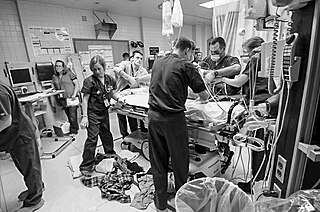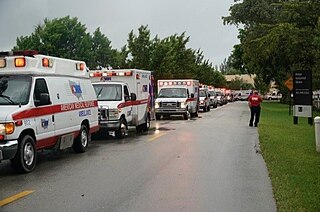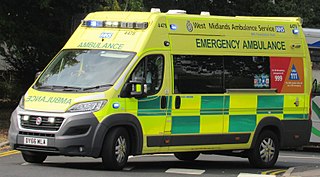
In medicine, triage is a practice invoked when acute care cannot be provided for lack of resources. The process rations care towards those who are most in need of immediate care, and who benefit most from it. More generally it refers to prioritisation of medical care as a whole. In its acute form it is most often required on the battlefield, or at peacetime when an accident results in a mass casualty which swamps nearby healthcare facilities' capacity.

Emergency medicine is the medical speciality concerned with the care of illnesses or injuries requiring immediate medical attention. Emergency physicians continuously learn to care for unscheduled and undifferentiated patients of all ages. As first-line providers, in coordination with Emergency Medical Services, they are primarily responsible for initiating resuscitation and stabilization and performing the initial investigations and interventions necessary to diagnose and treat illnesses or injuries in the acute phase. Emergency physicians generally practise in hospital emergency departments, pre-hospital settings via emergency medical services, and intensive care units. Still, they may also work in primary care settings such as urgent care clinics.

Emergency medical services (EMS), also known as ambulance services or paramedic services, are emergency services that provide urgent pre-hospital treatment and stabilisation for serious illness and injuries and transport to definitive care. They may also be known as a first aid squad, FAST squad, emergency squad, ambulance squad, ambulance corps, life squad or by other initialisms such as EMAS or EMARS.

An emergency medical technician (EMT), also known as an ambulance technician, is a health professional that provides emergency medical services. EMTs are most commonly found working in ambulances. In English-speaking countries, paramedics are a separate profession that has additional educational requirements, qualifications, and scope of practice.
A medical emergency is an acute injury or illness that poses an immediate risk to a person's life or long-term health, sometimes referred to as a situation risking "life or limb". These emergencies may require assistance from another, qualified person, as some of these emergencies, such as cardiovascular (heart), respiratory, and gastrointestinal cannot be dealt with by the victim themselves. Dependent on the severity of the emergency, and the quality of any treatment given, it may require the involvement of multiple levels of care, from first aiders through emergency medical technicians, paramedics, emergency physicians and anesthesiologists.

An ambulance is a medically equipped vehicle which transports patients to treatment facilities, such as hospitals. Typically, out-of-hospital medical care is provided to the patient.

An emergency department (ED), also known as an accident & emergency department (A&E), emergency room (ER), emergency ward (EW) or casualty department, is a medical treatment facility specializing in emergency medicine, the acute care of patients who present without prior appointment; either by their own means or by that of an ambulance. The emergency department is usually found in a hospital or other primary care center.

Paramedics in Germany are the main providers of emergency care in emergency medical services in Germany. There exist two professional levels regulated by federal law, the Rettungsassistent and the Notfallsanitäter.
London's Air Ambulance Charity is a registered charity that operates a helicopter emergency medical service (HEMS) dedicated to responding to serious trauma emergencies in and around London. Using a helicopter from 08:00 to sunset and rapid response vehicles by night, the service performs advanced medical interventions at the scene of the incident in life-threatening, time-critical situations.

The London Ambulance Service NHS Trust (LAS) is an NHS trust responsible for operating ambulances and answering and responding to urgent and emergency medical situations within the London region of England. The service responds to 999 phone calls across the region, and 111 phone calls from certain parts, providing triage and advice to enable an appropriate level of response.

The British Columbia Ambulance Service (BCAS) is an ambulance service that provides emergency medical response for the province of British Columbia, Canada. BCAS is one of the largest provider of emergency medical services in North America. The fleet consists of more than 500 ground ambulances operating from 183 stations across the province along with 80 support vehicles. Additionally, BCAS provides inter-facility patient transfer services in circumstances where a patient needs to be moved between health care facilities for treatment. BCAS also operates a medical evacuation program that utilizes both fixed-wing and rotary aircraft.

A paramedic in Australia is a health care professional who responds to and treats all types of medical and trauma emergencies outside of a hospital setting before and during transportation to an appropriate medical facility. Paramedics also work in the inter-facility transport environment where a paramedic will continue or upgrade medical care to a higher level while transporting a patient from one healthcare facility to another. Paramedics are able to treat patients in the pre-hospital setting, and can transport them to a hospital-based emergency department if deemed necessary. A new paramedic is evolving, the Paramedic Practitioner. The Paramedic Practitioner provides primary health care in a range of health settings and forms part of a multidisciplinary medical team. In Australia, use of the term paramedic is lawfully restricted to the use of those registered with AHPRA.

Emergency medical services in France are provided by a mix of organizations under public health control. The central organizations that provide these services are known as a SAMU, which stands for Service d'Aide Médicale Urgente. Local SAMU organisations operate the control rooms that answer emergency calls and dispatch medical responders. They also operate the SMUR, which refers to the ambulances and response vehicles that provide advanced medical care. Other ambulances and response vehicles are provided by the fire services and private ambulance services.

Emergency medical services in the United Kingdom provide emergency care to people with acute illness or injury and are predominantly provided free at the point of use by the four National Health Services (NHS) of England, Scotland, Wales, and Northern Ireland. Emergency care including ambulance and emergency department treatment is only free to UK residents and a charge may be made to those not entitled to free NHS care. The NHS commissions most emergency medical services through the 14 NHS organisations with ambulance responsibility across the UK.
ASHICE is one of several mnemonic acronyms used by emergency medical services in the United Kingdom and the Republic of Ireland to pass summarised advance details of a patient to the next group of persons or organisation dealing with them. In the English and Welsh NHSs the procedure is not used for non-critical patients on their eventual journey to hospital but is used as standarocedure for handovers of patients before transport to hospital where a site or event is staffed by trained personnel of both paid or voluntary ambulance services. This procedure is in addition to written records of the patient's personal and medical details and any treatment or medication applied prior to transport to the hospital.

A mass casualty incident describes an incident in which emergency medical services resources, such as personnel and equipment, are overwhelmed by the number and severity of casualties. For example, an incident where a two-person crew is responding to a motor vehicle collision with three severely injured people could be considered a mass casualty incident. The general public more commonly recognizes events such as building collapses, train and bus collisions, plane crashes, earthquakes and other large-scale emergencies as mass casualty incidents. Events such as the Oklahoma City bombing in 1995 and the September 11 attacks in 2001 are well-publicized examples of mass casualty incidents. The most common types of MCIs are generally caused by terrorism, mass-transportation accidents, fires or natural disasters. A multiple casualty incident is one in which there are multiple casualties. However the key difference from a mass casualty incident is that in a multiple casualty incident the resources available are sufficient to manage the needs of the victims. The issue of resource availability is therefore critical to the understanding of these concepts. One crosses over from a multiple to a mass casualty incident when resources are exceeded and the systems are overwhelmed

Magpas Air Ambulance is an emergency medical charity that provides pre-hospital emergency care, in the air or on land, including treatments normally only available in hospital. The charity operates 24/7 from its base in Cambridgeshire and is activated to seriously ill or injured patients in Cambridgeshire, Bedfordshire and the East of England – caring for a population of over 10 million.

Air medical services is a comprehensive term covering the use of air transportation, aeroplane or helicopter, to move patients to and from healthcare facilities and accident scenes. Personnel provide comprehensive prehospital and emergency and critical care to all types of patients during aeromedical evacuation or rescue operations aboard helicopter and propeller aircraft or jet aircraft.

Pre-hospital emergency medicine, also referred to as pre-hospital care, immediate care, or emergency medical services medicine, is a medical subspecialty which focuses on caring for seriously ill or injured patients before they reach hospital, and during emergency transfer to hospital or between hospitals. It may be practised by physicians from various backgrounds such as anaesthesiology, emergency medicine, intensive care medicine and acute medicine, after they have completed initial training in their base specialty.
The impact of the COVID-19 pandemic on hospitals became severe for some hospital systems of the United States in the spring of 2020, a few months after the COVID-19 pandemic began. Some had started to run out of beds, along with having shortages of nurses and doctors. By November 2020, with 13 million cases so far, hospitals throughout the country had been overwhelmed with record numbers of COVID-19 patients. Nursing students had to fill in on an emergency basis, and field hospitals were set up to handle the overflow.















